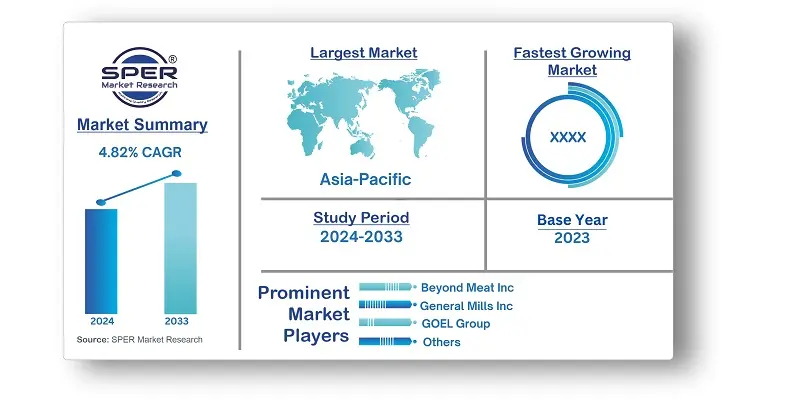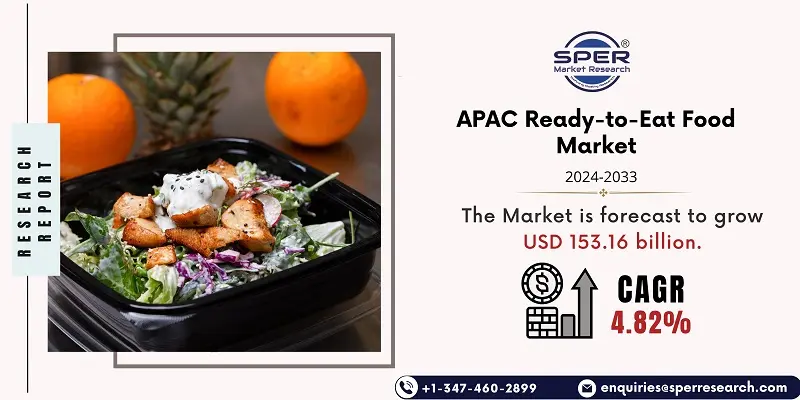
Asia-Pacific Ready-to-Eat Food Market Growth, Size, Trends, Demand, Revenue and Future Outlook
Asia-Pacific Ready-to-Eat Food Market Size- By Product Type, By Distribution Channel- Regional Outlook, Competitive Strategies and Segment Forecast to 2033
| Published: Apr-2024 | Report ID: FOOD2443 | Pages: 1 - 153 | Formats*: |
| Category : Food & Beverages | |||
- In March 2023: Goeld, a well-known frozen food manufacturer in India, debuted its newest product line, which is currently offered at Reliance Retail locations all over the country. The recently unveiled assortment of frozen food items consists of Idlis, Paneer Pakodas, and Pizza Pockets.
- February 2023: The ingenious vending machine that can make rapid meals is the result of a cooperation between Yokai Express, a food-tech business based in the United States, and Pulmuone, a Korean food powerhouse. Furthermore, according to Pulmuone, Yokai Express vending machines can be seen operating at a number of metro stations in Japan.


| Report Metric | Details |
| Market size available for years | 2020-2033 |
| Base year considered | 2023 |
| Forecast period | 2024-2033 |
| Segments covered | Product Type, By Distribution Channel |
| Regions covered | China, Japan, Australia, India, Rest of Asia-Pacific |
| Companies Covered | Beyond Meat, Inc., General Mills Inc., GOEL Group, McCain Foods Limited, PepsiCo Inc., Nestlé S.A., Pondok Abang, The Kellogg's Company, Unilever PLC, YO-KAI EXPRESS, Others. |
- Consumers
- Retailers
- Foodservice Providers
- Food Manufacturers
- Distributors and Wholesalers
- Caterers
- Health-Conscious Consumers
- Busy Professionals
- Travelers
| By Product Type: |
|
| By Distribution Channel: |
|
- Asia-Pacific Ready-to-Eat Food Market Size (FY’2024-FY’2033)
- Overview of Asia-Pacific Ready-to-Eat Food Market
- Segmentation of Asia-Pacific Ready-to-Eat Food Market By Product Type (Instant Breakfast/Cereals, Instant Soups and Snacks, Ready Meals, Baked Goods, Meat Products, Others)
- Segmentation of Asia-Pacific Ready-to-Eat Food Market By Distribution Channel (Supermarkets/Hypermarkets, Convenience/Grocery Stores, Speciality Stores, Online, Retail Stores, Others)
- Expansion Analysis of Asia-Pacific Ready-to-Eat Food Market
- Problems and Obstacles in Asia-Pacific Ready-to-Eat Food Market
- Competitive Landscape in the Asia-Pacific Ready-to-Eat Food Market
- Impact of COVID-19 and Demonetization on Asia-Pacific Ready-to-Eat Food Market
- Details on Current Investment in Asia-Pacific Ready-to-Eat Food Market
- Competitive Analysis of Asia-Pacific Ready-to-Eat Food Market
- Prominent Players in the Asia-Pacific Ready-to-Eat Food Market
- SWOT Analysis of Asia-Pacific Ready-to-Eat Food Market
- Asia-Pacific Ready-to-Eat Food Market Future Outlook and Projections (FY’2024-FY’2033)
- Recommendations from Analyst
1.1. Scope of the report1.2. Market segment analysis
2.1. Research data source2.1.1. Secondary Data2.1.2. Primary Data2.1.3. SPER’s internal database2.1.4. Premium insight from KOL’s2.2. Market size estimation2.2.1. Top-down and Bottom-up approach2.3. Data triangulation
4.1. Driver, Restraint, Opportunity and Challenges analysis4.1.1. Drivers4.1.2. Restraints4.1.3. Opportunities4.1.4. Challenges4.2. COVID-19 Impacts of the Asia-Pacific Ready-to-Eat Food Market
5.1. SWOT Analysis5.1.1. Strengths5.1.2. Weaknesses5.1.3. Opportunities5.1.4. Threats5.2. PESTEL Analysis5.2.1. Political Landscape5.2.2. Economic Landscape5.2.3. Social Landscape5.2.4. Technological Landscape5.2.5. Environmental Landscape5.2.6. Legal Landscape5.3. PORTER’s Five Forces5.3.1. Bargaining power of suppliers5.3.2. Bargaining power of buyers5.3.3. Threat of Substitute5.3.4. Threat of new entrant5.3.5. Competitive rivalry5.4. Heat Map Analysis
6.1. Asia-Pacific Ready-to-Eat Food Market Manufacturing Base Distribution, Sales Area, Product Type6.2. Mergers & Acquisitions, Partnerships, Product Launch, and Collaboration in Asia-Pacific Ready-to-Eat Food Market
7.1. Asia-Pacific Ready-to-Eat Food Market Value Share and Forecast, By Product Type, 2024-20337.2. Instant Breakfast/Cereals7.3. Instant Soups and Snacks7.4. Ready Meals7.5. Baked Goods7.6. Meat Products7.7. Others
8.1. Asia-Pacific Ready-to-Eat Food Market Value Share and Forecast, By Distribution Channel, 2024-20338.2. Supermarkets/Hypermarkets8.3. Convenience/Grocery Stores8.4. Speciality Stores8.5. Online Retail Stores8.6. Others
9.1. Asia-Pacific Ready-to-Eat Food Market Size and Market Share
10.1. Asia-Pacific Ready-to-Eat Food Market Size and Market Share By Product Type (2020-2026)10.2. Asia-Pacific Ready-to-Eat Food Market Size and Market Share By Product Type (2027-2033)
11.1. Asia-Pacific Ready-to-Eat Food Market Size and Market Share By Distribution Channel (2020-2026)11.2. Asia-Pacific Ready-to-Eat Food Market Size and Market Share By Distribution Channel (2027-2033)
12.1. Asia-Pacific Ready-to-Eat Food Market Size and Market Share By Region (2020-2026)12.2. Asia-Pacific Ready-to-Eat Food Market Size and Market Share By Region (2027-2033)12.3. China12.4. Japan12.5. Australia12.6. India12.7. Rest of Asia-Pacific
13.1. Beyond Meat, Inc.13.1.1. Company details13.1.2. Financial outlook13.1.3. Product summary13.1.4. Recent developments13.2. General Mills Inc.13.2.1. Company details13.2.2. Financial outlook13.2.3. Product summary13.2.4. Recent developments13.3. GOEL Group13.3.1. Company details13.3.2. Financial outlook13.3.3. Product summary13.3.4. Recent developments13.4. McCain Foods Limited13.4.1. Company details13.4.2. Financial outlook13.4.3. Product summary13.4.4. Recent developments13.5. PepsiCo Inc.13.5.1. Company details13.5.2. Financial outlook13.5.3. Product summary13.5.4. Recent developments13.6. Nestlé S.A.13.6.1. Company details13.6.2. Financial outlook13.6.3. Product summary13.6.4. Recent developments13.7. Pondok Abang13.7.1. Company details13.7.2. Financial outlook13.7.3. Product summary13.7.4. Recent developments13.8. The Kellogg's Company13.8.1. Company details13.8.2. Financial outlook13.8.3. Product summary13.8.4. Recent developments13.9. Unilever PLC13.9.1. Company details13.9.2. Financial outlook13.9.3. Product summary13.9.4. Recent developments13.10. YO-KAI EXPRESS13.10.1. Company details13.10.2. Financial outlook13.10.3. Product summary13.10.4. Recent developments13.11. Others
SPER Market Research’s methodology uses great emphasis on primary research to ensure that the market intelligence insights are up to date, reliable and accurate. Primary interviews are done with players involved in each phase of a supply chain to analyze the market forecasting. The secondary research method is used to help you fully understand how the future markets and the spending patterns look likes.
The report is based on in-depth qualitative and quantitative analysis of the Product Market. The quantitative analysis involves the application of various projection and sampling techniques. The qualitative analysis involves primary interviews, surveys, and vendor briefings. The data gathered as a result of these processes are validated through experts opinion. Our research methodology entails an ideal mixture of primary and secondary initiatives.



Frequently Asked Questions About This Report
PLACE AN ORDER
Year End Discount
Sample Report
Pre-Purchase Inquiry
NEED CUSTOMIZATION?
Request CustomizationCALL OR EMAIL US
100% Secure Payment






Related Reports
Our Global Clients
Our data-driven insights have influenced the strategy of 200+ reputed companies across the globe.






















